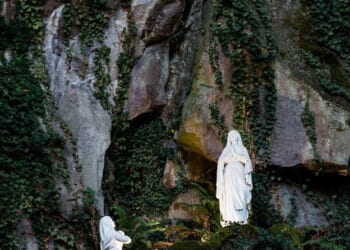Several B-1B Lancers were sent to Andersen AFB in Guam as part of an Air Force deployment that has since concluded. The aircrafts have since returned to the Dakotas.
The United States Air Force’s Bomber Task Force (BTF) 25-1 Indo-Pacific deployment may have concluded, as the Grand Forks Air Force Base (AFB), North Dakota, shared images of a Rockwell B-1B Lancer, assigned to the 28th Bomb Wing, arriving at the base this week. Earlier this year, the entire 28th BW was mobilized, with most of the long-range strategic bombers relocated from Ellsworth AFB, South Dakota, to Grand Forks—as Ellsworth prepares the base for the arrival of the Northrop Grumman B-21 Raider in the coming years.
However, a previously undisclosed number of Lancers were sent to Andersen AFB, Guam, as part of a BTF deployment that now appears to have concluded.
“A B1-B Lancer assigned to the 28th Bomb Wing at Ellsworth Air Force Base, South Dakota, arrives at Grand Forks Air Force Base, North Dakota, March 6, 2025. The B-1 was one of four aircraft redeploying from a Bomber Task Force deployment in the Indo-Pacific Theater,” stated an Air Force report.
BTF Lancer Mission Accomplished
BTF 25-1 in the Indo-Pacific began on January 27 and was noted to be “in support of the Pacific Air Forces’ training efforts with Allies, partners, and joint forces.”
While the bombers, aircrews, and an undisclosed number of support personnel could head to Guam, missing the wintery weather back in North Dakota, the time spent deployed was especially busy.
At least one B-1B Lancer deployed to the Indo-Pacific took part in joint air force drills last month with South Korean F-35 Lightning II and F-15 Eagle jets and U.S. F-16 Fighting Falcons. It marked the first exercises over the Korean Peninsula since President Donald Trump’s second term began.
In addition, a Lancer from the 34th Expeditionary Bomb Squadron, 28th AW, was sent to “support” the 2025 Aero India Air Show and Trade Exhibition. The U.S. Air Force long range bomber took part in four flyovers over two days of Yelahanka Air Force Station, which were meant to, “demonstrate U.S. airpower projection and readiness in the Indo-Pacific region,” the bomb wing also announced.
“The participation is a testament of our commitment to strengthen partnerships with India,” said Lt. Col. Robert Wasil, 34th expeditionary bomb squadron commander.
“We look forward to future opportunities to grow our relationship with the Indian Air Force and to furthering our involvement in the Indo-Pacific region.”
Just days after the flyover in India, one of the B-1B Lancers was employed in a “hot pit refueling” at Misawa Air Base, Japan. The “skilled technique [involves] aircraft ground crews add fuel to an aircraft with engines still running,” which allows the aircraft to take off and resume its mission quickly. It is a practice part of the U.S. Air Force’s Agile Combat Employment (ACE) mission.
“Proficiency is our priority as we must provide safe, secure, effective, and ready strategic deterrence when called upon,” Wasil added while commenting on the hot pit refueling exercise.
Lancers in the Birdbath
While deployed to Guam, the Lancers received some TLC, including a clear water rinse following the training flights.
“All aircraft stationed within 1.25 miles of salt water require a clear water rinse at least once every fifteen days unless washed first according to Air Force technical orders,” the 28th Bomb Wing explained.
However, that didn’t require the maintainers to get out a long hose and buckets. Andersen AFB is outfitted with the “Guam Strike Clear Water Rinse Facility,” colloquially known as “the birdbath.”
As previously reported, the facility was constructed at the base’s flight line in May 2013. It consists of eight water cannons built into the flight line that can spray clear water to the sides of an aircraft while the spray bars can rinse the underside.
Additional sprayers at the side of the flight line are angled to ensure the top of a warbird gets a fresh rinse. The sprayer is large enough to accommodate the Lancer and the Boeing B-52H Stratofortress and gentle enough to be used on the sensitive stealth coating of the Lockheed Martin F-22 Raptor.
The fresh water sprayed is necessary to remove corrosive substances, including salt, and helps protect an aircraft’s paint and other surfaces.
Now that the four B-1B Lancers are back in North Dakota, the bombers won’t need to undergo the fresh water rinses. However, as winter isn’t quite over, de-icing could still be in the cards, which takes fifteen to thirty minutes on the variable sweep-wing aircraft.
About the Author: Peter Suciu
Peter Suciu is a Michigan-based writer. He has contributed to more than four dozen magazines, newspapers, and websites, with over 3,200 published pieces and over a twenty-year career in journalism. He regularly writes about military hardware, firearms history, cybersecurity, politics, and international affairs. Peter is also a Contributing Writer for Forbes and Clearance Jobs. You can follow him on Twitter: @PeterSuciu. You can email the author: [email protected].
Image: Shutterstock/ Fotoluminate LLC.















